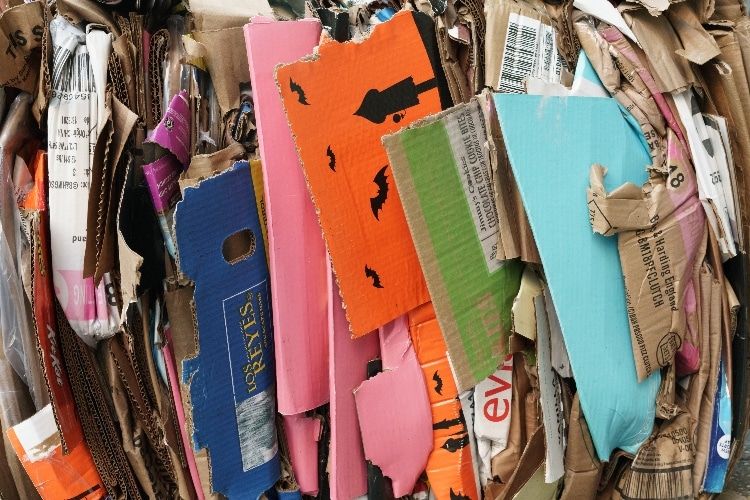Paper & Cardboard Recycling
Recycle Paper and Cardboard with Horizon Disposal Services
Paper and cardboard recycling represents more than a waste management strategy; it is a commitment to a sustainable future. Horizon Disposal Services works with individuals, businesses, and communities. Let’s actively contribute to this movement by adopting responsible recycling practices, supporting recycling initiatives, and choosing products with recycled content.
Making one ton of office print paper can consume up to twenty-four trees. Entire forests, habitats, and ecosystems are being destroyed. This is why encouraging responsible waste disposal is more important than ever. At Horizon Disposal, we believe that recycling paper and cardboard is integral to a sustainable and eco-friendly lifestyle.
Contact us for all your paper and cardboard needs. Whether you need just a few for your home or a whole office and industrial containers, we can help. We have the right equipment to handle large-scale paper and cardboard recycling.
Types of Paper You Can Recycle
Juice Cartons
Pizza Boxes
Cardboard and Paper
Cereal Boxes
Magazines
Calendars
Posters
Newspapers

Why Recycle Paper and Cardboard?
Paper Recycling paper is the process of taking used paper products and creating new paper products from them. Three types of paper material can be used to produce recycled paper products; mill broke, pre-consumer, and post-consumer. At our facility, we sort a post-consumer mixed paper product sold to mills.
Cardboard boxes are known to recyclers as “old corrugated containers” or “OCC.” They are made from two brown linerboard facings with a fluted or corrugated paper layer between them. Other boxes, including cereal, shoe, and tissue boxes, have a gray liner and are thinner than corrugated containers. These are known as chipboard or paperboard. Our facility also recycles quite a bit of cardboard sold to paper mills.
Forests are being cut, and trees are dropping at an unimaginable rate of 100 acres per minute. All this to produce paper which is normally used and disposed of without much thought. A plant takes a minimum of 15 to 20 years to grow into a tree but takes less than 10 minutes to be cut down, and on average one tree can yield about 700 paper grocery bags, which will be consumed in less than an hour by a supermarket!
For every ton of paper that is recycled, the following are saved:
- 17 trees
- 275 pounds of sulfur
- 350 pounds of limestone
- 9,000 pounds of steam
- 60,000 gallons of water
- 225 kilowatt hours
- 3.3 cubic yards of landfill space

Seamless Paper and Cardboard Recycling Process
Understanding the recycling process is critical to appreciating its impact. Paper and cardboard recycling typically involves several stages:
Collection
The process begins with the collection of used paper and cardboard. You can do this through curbside recycling programs, drop-off centers, or dedicated recycling bins.
Horizon Disposal Services makes collecting and recycling paper and cardboard more effortless. We provide quality recycling bins and hauling services, so you don’t have to deal with waste collection.
Sorting
This step ensures that we eliminate contaminants and that the materials are ready for recycling. We take all paper materials, from paper towels to cardboard boxes. Our facility uses advanced equipment to sort materials based on their type and quality. Different grades of paper products determine how they will be recycled.
Printing paper, for example, has a higher grade than a newspaper because newspapers have already been recycled several times. Paper can be recycled seven to eight times before the fibers become too short.
Pulping
Once we remove impurities, turn the recyclable paper and cardboard into pulp. Pulping usually entails mixing old paper products with water and chemicals. This process breaks down the fibers in the old or used paper. Afterward, it is chopped and heated, breaking it down further into organic material.
Cleaning
The pulp undergoes a cleaning process to remove inks, adhesives, and other impurities. This step is crucial for producing high-quality recycled material.
Reformation
The cleaned pulp is returned to manufacturers, who turn it into new paper or cardboard products. This step completes the recycling loop, creating a sustainable alternative to virgin materials.
Can Paper and Cardboard be Recycled Together?
Paper and cardboard are the most recyclable materials. These include newspapers, office papers, plates and cups, tissue paper, corrugated cardboard boxes, milk cartons, etc.
You can recycle paper and cardboard in one bin. Our advanced recycling machines will separate and remove items such as pins, plastic mail windows, tapes, and labels.
Importantly, prepare your paper and cardboard to ensure higher chances of successful recycling. For instance, remove grease and tape so they don’t clog the equipment.
Benefits of Paper and Cardboard Recycling to The Environment
Paper and cardboard recycling is pivotal in preserving natural resources and reducing environmental degradation. It helps conserve trees, which is essential in maintaining ecological balance and mitigating climate change. Trees clean the air by absorbing carbon dioxide and giving out oxygen, which helps combat global warming.
Furthermore, recycling paper and cardboard reduces methane emissions into the atmosphere through decay.
Using recycled material instead of new paper and cardboard helps protect the environment and conserve vital ecosystems.
Saves the Landfill
Another advantage of paper and cardboard recycling lies in reduced waste. Recycling diverts these materials from landfills, where they would otherwise contribute to the growing waste problem.
Landfills generate harmful greenhouse gases, contaminate soil and water, and pose severe threats to public health. By opting for recycling, we extend landfills’ lifespan and alleviate the environmental burden associated with waste disposal.
Embracing Recycled Paper and Cardboard
Choosing recycled paper and cardboard products is a simple yet impactful way to contribute to a green lifestyle. From packaging materials to office supplies, the market offers multiple options that help reduce the demand for virgin resources.
Consumers actively participate in the circular economy by opting for recycled alternatives and promoting responsible consumption and production practices.
